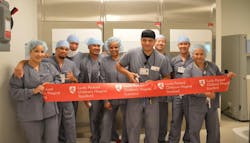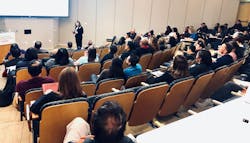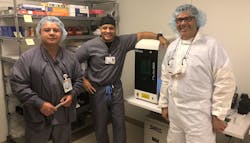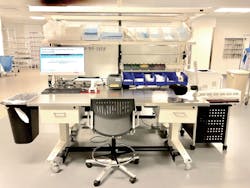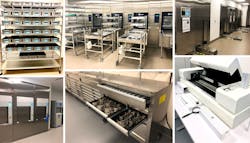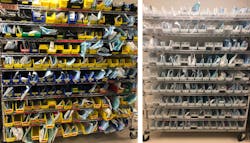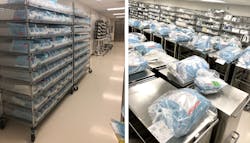Packard Children’s makes SPD matter by reinventing itself
The Sterile Processing Department at Lucile Packard Children’s Hospital’s path to performance improvement began in 2002 when Stanford Children’s Health set out to build a 521,000 square-foot state-of-the-art extension of the Children’s Hospital. This represented an ambitious endeavor that culminated with the grand opening of a $1.2-billion Children’s Hospital in December 2017. They had planned to build the most technologically advanced, environmentally sustainable and family-friendly hospital for children and expectant mothers. This new facility doubled the size of the hospital to 844,000 square feet, added surgical suites to decrease wait times and integrated imaging and surgery, further decreasing radiation exposure for its young patients.
This expansion included:
- Opening 149 new patient beds, bringing the total to 361
- Increasing the number of surgical suites to 13.
- Featuring the only Pediatric Neuro-Hybrid Surgery Suite in California, allowing surgeons to receive real-time images during surgery. One benefit: Surgeons now can confirm that a patient’s entire brain tumor is removed prior to the incision being closed.
Packard also built what it views as a “best in class” Sterile Processing Department (SPD). Prior to expansion, SPD occupied a 1,512 square-foot area adjacent to the surgical suites. The SPD also housed prep-and-pack and decontamination. This was supported by 18 certified full- time SPD Technicians. This space supported seven operating rooms prior to the expansion. Hospital administrators wanted to make sure they had adequate infrastructure to support the new surgical suites and the reprocessing efforts for the more than 25 inpatient/outpatient clinics. Previously, Stanford Hospital’s SPD handled reprocessing functions. Administration also anticipated the need to procure more advanced washers, steam sterilizers and high-level disinfection technology to handle reprocessing increasingly complex medical devices.
“Our old space, we were like packed sardines trying to work in a tight space with our elbows bumping into each other with limited space to maneuver. The new SPD is totally the opposite. Top-notch equipment, washers, sterilizers, both [low-temperature gas plasma] and steam!”
– Miguel Claros, Shift Lead
Perhaps no better test exists for a team than to move into a new space while still maintaining the day-to-day level of care needed for the patients in the hospital. In December 2017 SPD moved into its new space with new leadership in both Perioperative Services and Sterile Processing. SPD quickly realized the stark differences between the old and new footprint, as well as the challenges and opportunities ahead. Although the previous space was 1,512 square feet, it fostered an environment where staff found it easier to work together. Communication was easier because team members worked in close proximity to one another. However, they felt one downside was the lack of adequate space to support proper workflow and storage.
SPD’s new space spans 12,079 square feet, which includes a 511-square-foot “mini” SPD. The team found that the much larger footprint presented some logistical challenges because the OR and SPD were now located on different floors but team members adapted, many times diligently speeding down the hall to get the OR what they needed. Adjusting to the new work environment also involved learning how to operate new equipment, including a new tracking system, washers, cart washer and sterilizers. In addition, SPD also expanded its scope of service to include reprocessing additional products used in more ORs and more outpatient/inpatient clinics. This motivated SPD to hire more full-time technicians, bringing its staff to 27 from 18 to improve workflow and integrate new technology to support SPD’s quality performance.
Cross collaboration, communication
“Culture changed in a positive way [as] new techs and investment – in our department from management let SPD know we’re valuable.”
– Marvyn Ordesta, Certified Sterile Processing Tech II
Once in the new space, SPD concentrated on collaboration with all of its customers, end users, hospital partners and neighboring hospitals. The motivation for this was to elevate SPD’s role by showing its importance relative to hospital operations and the patients served. SPD’s first outreach was to publish its newsletter, “Fighting Dirty Daily,” which highlighted the move, innovation and the team that made it happen. SPD saw the newsletter as a way to educate hospital colleagues about SPD’s new look and expansive work for customers. Physicians, nurses, technicians and administration all received the first issue that SPD also posted on LinkedIn. Administration acknowledged SPD and announced hospital-wide SPD Week, which involved celebration, recognition, empowerment, education and collaboration.
SPD also hosted its first cross-collaborative symposium, “Culture, Collaboration & Cutting Edge Technology,” which brought together manufacturers, Infection Control, Perioperative Nursing, physicians, OR Techs, SPD Techs and students, an audience of more than 150 representing more than 40 healthcare-related institutions, which culminated with a tour of the new SPD department.
Training for education
“I am grateful for people who motivate me to grow, work harder, achieve and smile. SPD is my second family.”
– Melina Witherspoon, Lead Tech
Packard Children’s supports SPD education and training to the extent that 90 percent of our team members are certified, while the remaining 10 percent are scheduled to earn their certification once they have completed their training. SPD leadership also encourages its team members to obtain additional certifications to increase their level of competency and knowledge. By focusing on culture and team, SPD believes it can benefit from its investment in education with a fully engaged team fortified by institutional and industry knowledge. In fact, these efforts led to the promotion of two techs to supervisor and lead, with their certificates displayed on the department’s wall of fame.
To develop a pipeline of new SPD techs, Packard Children’s partners with the local community colleges to recruit students and introduce them to the importance of SPD in healthcare. To date, SPD added two students to the team. In January, SPD also added an Educator dedicated solely to the department.
Etched in innovation
“As a show whose mission it is to identify and promote the best minds and best practices currently in the sterile processing industry, the Beyond Clean podcast has been thoroughly impressed with the commitment and thought leadership found in the SPD lead team at LPCH. From the stellar work they’ve done in creating a one-of-a-kind clinic customer handbook, to the willingness they’ve had to share their department design knowledge through our podcast with other department leaders and frontline technicians in the industry, they have truly become a model for the kind of innovation and collaboration necessary to take device reprocessing to the next level. Making improvements is one thing, but owning the mission to spread that successful model out to other SPD departments who may be struggling through the same issues is the mark of something great.”
– Hank Balch, Principal Consultant, and former leader of the 2016 SPD Department of the Year, Jewish Hospital, Louisville, KY
To deliver the right instrument at the right time and in which the devices are contaminant-free/sterile every time, Packard Children’s SPD purchased a surgical instrument laser. This device follows metallurgic industry protocols, which includes rebuilding the passivation layer to avoid rusting. With this device SPD gained the capability to add a permanent 2-D mark on all of the individual peel-packed devices for the OR. SPD inputs these data into its computer tracking system to record details about usage, location and appropriate name. SPD also uses the laser on relevant items for its clinic customers and others in anesthesia and electrophysiology lab. SPD sees this development as progress toward tracking devices to the patient via Unique Device Identification (UDI).
SPD also invested in a cloud-based system to facilitate its loaner management inventory from vendors by closing the communication gaps between surgeons, OR and SPD personnel and device manufacturers.
SPD introduced a fully automated rigid endoscope testing machine to help staff inspect Packard Children’s large inventory of rigid and semi-rigid scopes. The machine measures the view angle, light fibers, field of view, light transmission, focus and color balance, accounting for a more comprehensive way of inspecting these devices versus a technician simply looking through the lens. Along with the light guide cable tester, SPD staff can determine whether the camera, tower and/or end user contributed to a malfunction during the case. SPD also gained the ability to track a device’s history that includes validating if the original equipment manufacturer or third-party independent service organization repaired the device according to OEM specifications.
As part of an ongoing creative project, SPD reached out to “local talent” with in Silicon Valley explore and develop solutions applicable to SPD operations, opening up a dialog of what’s possible in the future. SPD also collaborates with Packard Children’s physicians to discuss innovative ideas that can drive efficiency and optimization. In fact, orthopedic surgeon Kevin Shea, M.D., who practices at Stanford University Medical Center and Packard Children’s Hospital remains fully engaged with the department, spending time with Techs to exchange feedback on process improvement and support. Shea calls SPD the “Offensive Line” of the OR, which couldn’t be successful without Sterile Processing.Pursuing outcomes, quality
“What makes LPCH great is their commitment to mission. Leadership takes an approach of empowerment, allowing supervisors and technicians to have creative control and take accountability for the application and implementation of new technology and proper process. It’s the culture of the institution and the quality that truly makes the patients safer. This department has established a world-class culture that is capable of utilizing technology that has been invested into setting a new standard for measurable quality that can be replicated with every procedure.”
– Justin Poulin, Clinical Operations Executive
Within three months of moving into its new base of operations, SPD was able to repatriate all clinic reprocessing done at the main hospital. SPD first identified gaps in tracking the assets across multiple clinics and locations, starting with the generic requisition form. SPD revised and customized the clinic form so that each clinic would have all the applicable fields pre-populated with data, detailing unit, cost center, phone number, address and surgical instruments that would be sent. Next, SPD changed how it received items from the clinics by standardizing all transport bins to reduce variability and facilitate reprocessing through the cart washer. Each clinic has its own bar-coded decontamination/prep-and-pack bin for these instruments to be transferred on receipt within SPD. These bins travel throughout the decontamination/prep-and-pack process and are not co-mingled to prevent loss. SPD then uses its laser to mark each instrument with its own unique code for the team to easily identify the owner and name of each individual device. This instrument marking laser enables the capability to place permanent marks as well as clearly identify service line and nomenclature, making it easier for the technicians to identify the device. Prior to repatriating these clinic items, Stanford University Medical Center’s SPD was charging Packard Children’s more than $34,000 per month to reprocess these devices, which ultimately saved Packard Children’s SPD more than $409,000 annually.
To further assist technicians in identifying medical device issues, SPD added a microscope to every workstation, which allows them to inspect for micro cracks, pitting, staining and bioburden, and not rely solely on the human eye when inspecting. SPD also improved its peel pack inventory by standardizing storage display and access, making it easier for the OR staff to select their peel packs when needed.
SPD also consolidated high-level disinfection/automated endoscope reprocessor units to improve workflow and be able to use borescope technology to provide a number of technicians with something they had to experience – seeing the inside of a scope or a lumen. SPD set up two stations to enable this process, including one in decontamination for scope inspection post manual pre-cleaning and the other in prep-and-pack so the team can inspect scopes post-AER or inspect lumens post-automated washing.
Fusing people, culture
“We are a close family.”
– Rigo Cardenas- Supervisor
To keep pace with the increased current and projected volume, SPD recognized it needed to add more staff members but stressed the desire to recruit technicians who care about the complexity and importance of their job and were willing to learn and pay attention to detail. SPD also emphasized that “culture trumps talent” the team selected for cultural fit more than technical skills, which could be increased with education and training once they started.
Last summer, SPD added six new team members to its second shift, which complemented the existing senior staff, along with the infusion of students from across the Bay area. Last year, SPD recorded an 82 percent retention rate among staff members and hope to reach 100 percent in 2019. During SPD Week last year, each team member received a custom-embroidered hat and jacket designed and made by homeless youth though the non-profit organization New Avenues for Youth. The logo includes the “We Fight Dirty Daily” slogan and identifies Lucile Packard Children’s Hospital SPD team.
“Perioperative services at LPCH is comprised of several departments and talents – SPD, EVS, PARC, PreOp, PACU, Materials [and] SSI – all of which are interconnected and integral to excellence for each patient we serve. We could not survive independently, and only together do we create the safest, highly reliable experience for our patients. The SPD team of LPCH are the most highly skilled staff that I have ever worked with in my 35 years of nursing. The surgeons, nurses, STs, Anesthesia providers and even those outside the Periop’s setting count on and trust that the service SPD delivers is first-rate. SPD matters to the success of Periop and beyond.”
– Jean Stroud, Director of Perioperative Services

